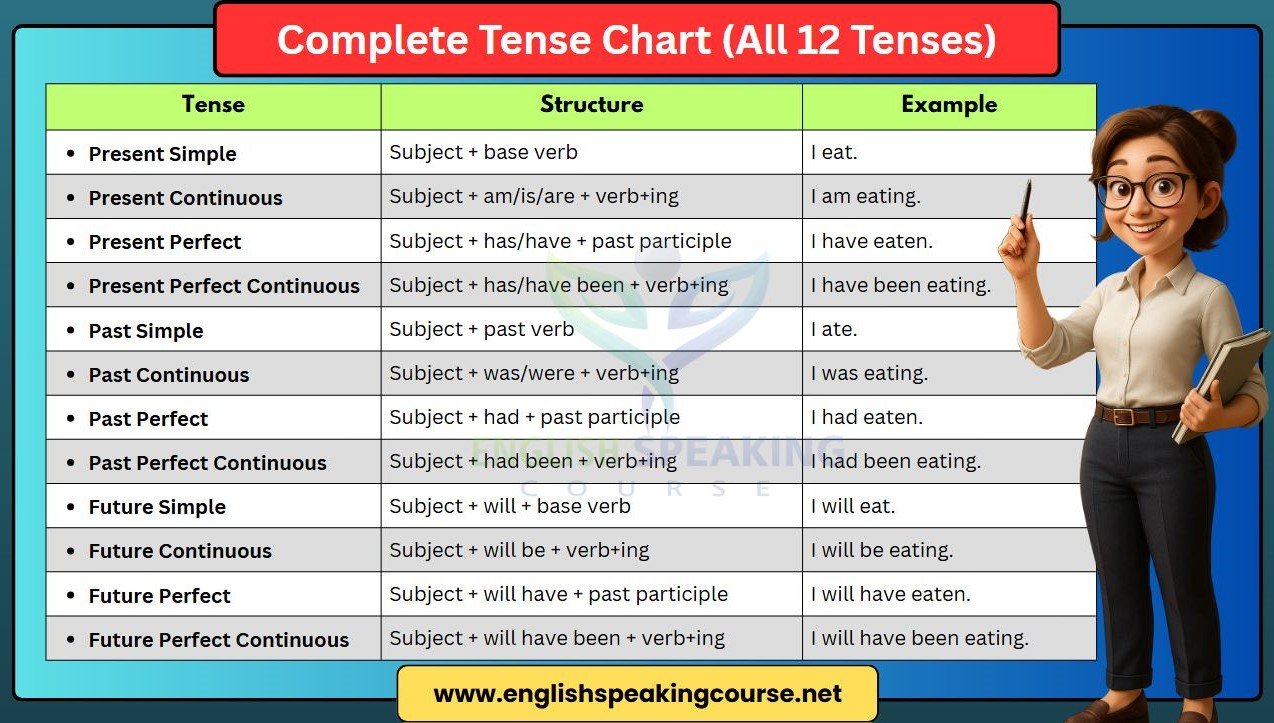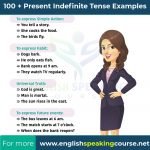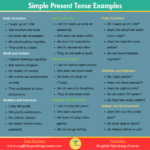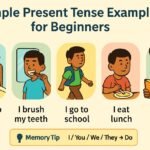Table of Contents
ToggleIntroduction – What is a Tense Chart?
If you’re just starting to learn English, understanding tenses can feel a little confusing. That’s where a Tense Chart comes in—it’s a simple tool that shows you how verbs change depending on time (past, present, or future).
A Tense Chart helps you see the patterns in English grammar. Instead of memorizing random rules, you can look at the chart and clearly understand how each tense is formed and used. It’s like a shortcut to speaking and writing better English.
In English, there are three main tenses:
- Present Tense – What is happening now
- Past Tense – What has already happened
- Future Tense – What will happen later
Each of these has four parts, making 12 tenses in total. Don’t worry—it’s easier than it sounds. This blog will guide you through each one step by step with examples and tips.
So, let’s start exploring the full Tense Chart and how it can help you learn English faster and better!
What is Tense in English Grammar?
In simple words, tense means the time of an action. It tells us when something happens—now, before, or later. In English grammar, we use different verb forms to show the time clearly.
For example:
- I eat lunch. → Present (now)
- I ate lunch. → Past (before)
- I will eat lunch. → Future (later)
So, the verb changes based on time. That’s why tenses are so important in English. If you use the wrong tense, the meaning of your sentence can change completely.
💡 Why should you care about tenses?
Because using the correct tense makes your speaking and writing clear, correct, and easy to understand. Whether you’re talking to someone, writing an email, or answering a question, tenses help express your message properly.
And here’s the good news: with a well-organized Tense Chart, you don’t need to memorize everything—you can learn the structure of all 12 tenses easily.
🪄 Tip: If you’re just beginning, start with simple present, past, and future tenses. Once you’re comfortable, move on to the perfect and continuous forms.
Tense Chart Overview
Now that you understand what tenses are, let’s look at the Tense Chart. This chart shows all 12 tenses in a simple and organized way. It includes the name of the tense, how it’s formed (structure), and one short example for each.
📘 Complete Tense Chart
Tense Name | Structure | Example Sentence |
Present Simple | Subject + base verb | I play football. |
Present Continuous | Subject + am/is/are + verb+ing | I am playing football. |
Present Perfect | Subject + has/have + past participle | I have played football. |
Present Perfect Continuous | Subject + has/have been + verb+ing | I have been playing football. |
Past Simple | Subject + past verb | I played football. |
Past Continuous | Subject + was/were + verb+ing | I was playing football. |
Past Perfect | Subject + had + past participle | I had played football. |
Past Perfect Continuous | Subject + had been + verb+ing | I had been playing football. |
Future Simple | Subject + will + base verb | I will play football. |
Future Continuous | Subject + will be + verb+ing | I will be playing football. |
Future Perfect | Subject + will have + past participle | I will have played football. |
Future Perfect Continuous | Subject + will have been + verb+ing | I will have been playing football. |
This chart gives you a full picture of how verbs change in different tenses. It’s a great tool for learners who want to understand English grammar step by step.
💡 Pro Tip: Keep this Tense Chart near your study table. You can even use a Book Holder or a Reading Stand to keep it in front of you while practicing!
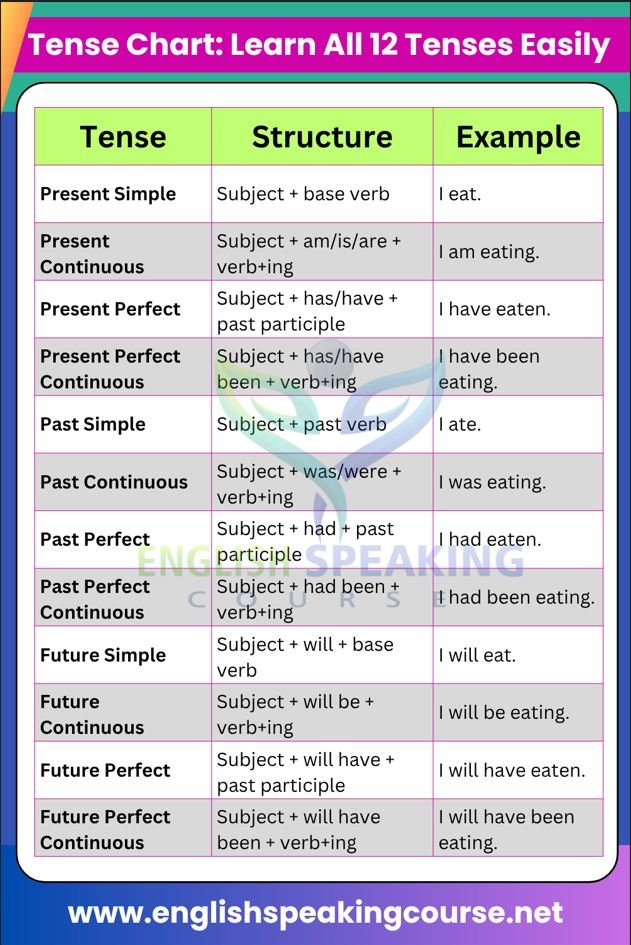
Present Tense (4 Types)
The Present Tense talks about actions that happen now, regularly, or are currently in progress. It has four types. Let’s look at them with easy explanations and examples.
🔹 1. Present Simple Tense
👉 Use: Daily habits, facts, general truths
👉 Structure: Subject + base verb
✅ Example: She drinks water every morning.
💡 Tip: Add -s or -es to the verb for he, she, it.
🔹 2. Present Continuous Tense
👉 Use: Actions happening right now
👉 Structure: Subject + am/is/are + verb+ing
✅ Example: I am learning English now.
📌 A great way to practice this is to speak aloud. Use a Microphone or a Smart Speaker like Alexa to make learning more interactive!
🔹 3. Present Perfect Tense
👉 Use: Actions completed recently or with present connection
👉 Structure: Subject + has/have + past participle
✅ Example: They have finished their homework.
🔹 4. Present Perfect Continuous Tense
👉 Use: Actions that started in the past and are still continuing
👉 Structure: Subject + has/have been + verb+ing
✅ Example: He has been studying for two hours.
💬 Quick Practice Tip: Try saying sentences using all four present tenses in front of a mirror. Or record yourself using your Headphones with mic for better clarity and confidence!
Past Tense (4 Types)
The Past Tense tells us about actions that happened before now—yesterday, last week, or even a moment ago. Like present tense, it also has four types. Let’s break them down simply.
🔹 1. Past Simple Tense
👉 Use: Completed actions in the past
👉 Structure: Subject + past verb
✅ Example: She visited her grandmother yesterday.
💡 Tip: Use regular or irregular past verbs (played, went, ate).
🔹 2. Past Continuous Tense
👉 Use: Ongoing actions in the past
👉 Structure: Subject + was/were + verb+ing
✅ Example: I was watching TV at 8 PM.
🪑 Try practicing past tense writing while sitting comfortably at your desk. A Comfortable Study Chair can make long grammar sessions easier on your back!
🔹 3. Past Perfect Tense
👉 Use: An action completed before another past action
👉 Structure: Subject + had + past participle
✅ Example: They had left before I arrived.
🔹 4. Past Perfect Continuous Tense
👉 Use: Action continuing up to a point in the past
👉 Structure: Subject + had been + verb+ing
✅ Example: She had been reading for an hour before dinner.
💬 Practice Tip: Write short stories using different past tenses. Keep your hands free using a Laptop Table to type comfortably while you learn.
Future Tense (4 Types)
The Future Tense is used to talk about actions that will happen later, not now or in the past. It also has four types, and once you understand the pattern, it becomes easy to use in daily conversations.
🔹 1. Future Simple Tense
👉 Use: For actions that will happen in the future
👉 Structure: Subject + will + base verb
✅ Example: I will call you tomorrow.
💡 “Will” is the key word here—it shows future time.
🔹 2. Future Continuous Tense
👉 Use: Ongoing actions that will be happening in the future
👉 Structure: Subject + will be + verb+ing
✅ Example: She will be studying at 9 PM.
🪄 Want to stay focused while studying grammar? Try using Noise-Cancelling Headphones to block out distractions and concentrate better.
🔹 3. Future Perfect Tense
👉 Use: Actions that will be completed before a certain time in the future
👉 Structure: Subject + will have + past participle
✅ Example: They will have finished the project by next week.
🔹 4. Future Perfect Continuous Tense
👉 Use: Actions continuing up to a point in the future
👉 Structure: Subject + will have been + verb+ing
✅ Example: By 10 PM, I will have been working for 6 hours.
📖 Keeping a grammar notebook or using English Conversation Practice Books regularly helps you build strong habits for future tenses and beyond.
Full Tense Chart for Quick Revision
Now that you’ve learned all 12 tenses with simple examples, here’s the full Tense Chart again. You can use this chart as a reference anytime you’re practicing or confused about a verb form.
📚 Complete Tense Chart (All 12 Tenses)
Tense | Structure | Example |
Present Simple | Subject + base verb | I eat. |
Present Continuous | Subject + am/is/are + verb+ing | I am eating. |
Present Perfect | Subject + has/have + past participle | I have eaten. |
Present Perfect Continuous | Subject + has/have been + verb+ing | I have been eating. |
Past Simple | Subject + past verb | I ate. |
Past Continuous | Subject + was/were + verb+ing | I was eating. |
Past Perfect | Subject + had + past participle | I had eaten. |
Past Perfect Continuous | Subject + had been + verb+ing | I had been eating. |
Future Simple | Subject + will + base verb | I will eat. |
Future Continuous | Subject + will be + verb+ing | I will be eating. |
Future Perfect | Subject + will have + past participle | I will have eaten. |
Future Perfect Continuous | Subject + will have been + verb+ing | I will have been eating. |
📌 Tip: Print this Tense Chart or keep it open on your device when practicing grammar. You can place it on a Desk Organizer or stand it up using a Book Holder for easy access during your study time.
Examples Using Each Tense
Let’s look at one simple example sentence for each of the 12 tenses. This will help you see the difference between them in real-life use. All the sentences are short and easy to understand—perfect for beginners!
🟢 Present Tense Examples
- Present Simple: I play football every day.
- Present Continuous: She is cooking dinner now.
- Present Perfect: They have finished their homework.
- Present Perfect Continuous: He has been reading for an hour.
🔵 Past Tense Examples
- Past Simple: We watched a movie yesterday.
- Past Continuous: I was sleeping at 10 PM.
- Past Perfect: She had already left when I arrived.
- Past Perfect Continuous: He had been working all night.
🟣 Future Tense Examples
- Future Simple: I will travel next week.
- Future Continuous: They will be playing at 5 PM.
- Future Perfect: She will have submitted the report by tomorrow.
- Future Perfect Continuous: By 6 PM, I will have been studying for 3 hours.
💡 Practice Tip: Try writing similar sentences using your own life or routine. Use a Spoken English Book for Beginners for more practice examples and speaking exercises.
Tips to Remember Tenses Easily
Learning all 12 tenses can feel like a lot at first—but don’t worry! With some simple tricks and regular practice, you can remember them easily and use them confidently in daily life.
Here are some easy tips to help you remember tenses better:
✅ 1. Group the Tenses by Time
Break the 12 tenses into 3 groups:
- Present Tenses (4)
- Past Tenses (4)
- Future Tenses (4)
This makes it easier to focus on one group at a time instead of learning everything at once.
✅ 2. Use a Visual Tense Chart
Keep a printed Tense Chart or use a digital one. You can stick it near your study area using a Reading Stand or a Study Lamp for better focus and lighting.
Looking at the chart often helps your brain remember the patterns naturally.
✅ 3. Make Mini Flashcards
Write each tense with one example on small cards. Carry them with you and review when you’re free—like during travel, breaks, or before sleeping.
✅ 4. Practice Speaking Daily
Speak out loud using tenses. For example:
- Today I eat breakfast at 8 AM. (Present Simple)
- Yesterday I ate at 9. (Past Simple)
- Tomorrow I will eat early. (Future Simple)
You can also practice with a friend, or even speak to your Smart Speaker like Alexa to build confidence in real conversations.
✅ 5. Start with Simple Sentences
Don’t try to use long or difficult sentences in the beginning. Just say or write short, simple lines. Once you’re confident, you can build longer sentences.
👉 Consistency is more important than perfection. Even 10–15 minutes of daily practice with a good English Conversation Practice Book can make a big difference!
Recommended English Learning Tools
Learning tenses becomes easier and more effective when you use the right tools. Here are some helpful resources that beginners can use to practice grammar, improve focus, and build strong English habits.
These tools are simple, affordable, and especially helpful if you’re learning English at home.
📘 1. Spoken English Books for Beginners
These books are written in easy language and include real-life examples. Perfect for practicing tenses in conversations.
👉 Check it out on Amazon
📗 2. English Conversation Practice Books
These guidebooks provide practical speaking situations—like talking at a shop, with friends, or during an interview.
👉 View on Amazon
💡 3. Study Lamps
A good study lamp helps you focus during evening or night study sessions. Bright light = better concentration.
👉 See this top-rated study lamp
🖥️ 4. Laptop Tables
If you study on your bed or floor, a laptop table can make your learning space more comfortable and organized.
👉 Check this useful table
🎧 5. Noise-Cancelling Headphones
These help you block outside noise and focus while watching grammar videos, listening to lessons, or doing speaking practice.
👉 Get this headphone
🗣️ 6. Smart Speaker (like Alexa)
You can practice English speaking by asking Alexa questions or giving voice commands in English. It’s fun and helpful for beginners!
👉 Explore Alexa on Amazon
💡 Bonus Tip: Use a Desk Organizer to keep your grammar books, notebooks, and tools neatly in one place. A clean study space makes a big difference in your learning mood!
FAQ – Tense Chart
Here are some common questions that English learners often ask about Tense Chart and grammar. These simple answers will help clear your doubts and make learning easier.
❓ What is a Tense Chart?
A Tense Chart is a simple table that shows all 12 English tenses, their structures, and examples. It helps you understand when and how to use different verb forms based on time.
❓ How many tenses are there in English?
There are 12 main tenses in English:
- 4 Present Tenses
- 4 Past Tenses
- 4 Future Tenses
Each one shows a different time and type of action.
❓ Why is a Tense Chart important?
Because it gives you a clear overview of how English grammar works. Instead of guessing, you can quickly check the structure and use the correct tense while speaking or writing.
❓ Which tense should I learn first?
Start with the Present Simple Tense. It’s the most commonly used tense in daily conversation. Then move on to Past and Future tenses. You can follow the order of the Tense Chart to stay organized.
❓ How can I practice tenses every day?
- Write 2–3 sentences using each tense daily
- Speak short examples aloud
- Use tools like English Practice Books
- Try recording your voice with Earphones
- Talk to Alexa or a language partner
Conclusion – Master English with the Tense Chart
Learning English grammar can feel tough at first—but with the help of a clear and simple Tense Chart, you can understand the rules faster and speak more confidently.
We covered:
- What a Tense Chart is
- The 12 English tenses with examples
- Tips and tricks to remember tenses easily
- Helpful tools and books to improve faster
Remember, you don’t have to learn everything in one day. Start small. Practice one tense at a time. Use real-life examples, speak aloud, and review the chart often. And most importantly, don’t be afraid to make mistakes—mistakes are part of learning!
💬 Tip: Set up a clean, focused study area with tools like a Study Lamp and a Book Holder. It helps you stay organized and motivated.
So, keep your Tense Chart close, practice daily, and watch your English grow stronger every week. You’ve got this!
